Linear Stability Analysis of the Cahn–Hilliard Equation in Spinodal Region
Abstract
We study a linear stability analysis for the Cahn–Hilliard (CH) equation at critical and off-critical compositions. The CH equation is solved by the linearly stabilized splitting scheme and the Fourier-spectral method. We define the analytic and numerical growth rates and compare these growth rates with respect to the different average levels. In this study, the linear stability analysis is conducted by classifying three average levels such as zero average, spinodal average, and near critical point levels of free energy function, in the one-dimensional (1D) space. The numerical results provide insight for the dynamics of CH equation at critical and off-critical compositions.
1. Introduction
The results of equations (3) and (4), respectively, show that the conservation of total mass holds, and the total energy does not increase with respect to time. Figure 1 represents a double-well potential F(ϕ), its corresponding first and second derivatives. Here, the spinodal region is defined by the gray-colored region where the second derivative is negative, i.e., F′′(ϕ) < 0. In this region, ϕ is unstable and then phase separation occurs. With these various applications of the CH equation, many researchers have proposed new efficient numerical methods [22–24]. Usually, in the stage of verifying the numerical method, the linear stability analysis is used. In [25], the linear stability was used for local equilibrium of Boltzmann equation. In [26], the stability analysis of the advective CH equation was employed to define the perturbation to investigate the instability of wave packets. In this paper, we shall present a clear standard for this test by defining linear and nonlinear regimes.
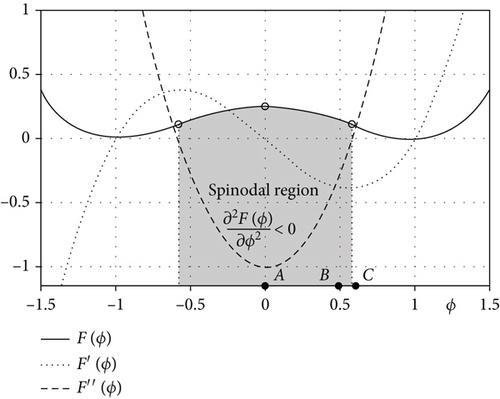
The main purpose of this paper is to numerically investigate the dynamics of phase separation in binary mixtures with different average concentrations using the CH equation in the one-dimensional (1D) space. In addition, we propose criteria for linear regimes with small differences between numerical solutions and linear solutions.
This paper is organized as follows. The Fourier-spectral method is introduced in Section 2 for numerical solution. Section 3 provides numerical results and simulations with linear stability analysis. Conclusions are discussed in Section 4.
2. Numerical Solution
As a consequence, we can compute the updated numerical solution by applying the inverse discrete Fourier transform (6).
3. Numerical Experiments
In this section, we define growth rate of the CH equation and compare analytic growth rate with numerical growth rate. We also define an error between the analytic solution and the numerical solution. Through several numerical experiments about the growth rate and the error, we investigate the numerical behaviour at different spinodal points. Then, we propose linear and nonlinear regimes.
3.1. Analytic and Numerical Growth Rates
Here, ‖·‖∞ denotes the maximum norm.
3.2. Convergence Test
In this section, we verify convergence of the numerical growth rate. For numerical test, we use ϕ(x, 0) = ϕave + 0.001cos(10πx), ϕave = 0, and ε = 0.02 in Ω = (0, 1).
Table 1 shows the numerical growth rate at time T = 0.004 for various Δt = T/Nt and h = 1/Nx. Here, the analytic growth rate is λ = 597.3241. In Table 1, we can see that the numerical growth rate converges to the analytic one as Δt and h decrease.
| Nt\Nx | 23 | 24 | 25 | 26 | 27 |
|---|---|---|---|---|---|
| 211 | 304.2649 | 594.2164 | 594.2139 | 594.2139 | 594.2139 |
| 212 | 304.5360 | 595.7570 | 595.7545 | 595.7545 | 595.7545 |
| 213 | 304.6718 | 596.5303 | 596.5278 | 596.5278 | 596.5278 |
| 214 | 304.7397 | 596.9177 | 596.9152 | 596.9152 | 596.9152 |
| 215 | 304.7737 | 597.1116 | 597.1091 | 597.1091 | 597.1091 |
| 216 | 304.7907 | 597.2086 | 597.2061 | 597.2061 | 597.2061 |
| 217 | 304.7992 | 597.2571 | 597.2546 | 597.2546 | 597.2546 |
3.3. Linear Stability Analysis
From now on, we implement the linear stability analysis with the constant solution ϕ = ϕave. In the every numerical experiment, we use the constant to adjust the interfacial thickness. As long as do not more mentioned, the numerical parameters use such as Nx = 128, h = 1/Nx, Δt =2e-7, α(0) = 0.001, ε = ε11, and T is total time. In addition, we use three different value ϕave = 0, 0.4, and 0.6 which are in spinodal region and near critical points of free energy. Note that these values are indicated points A, B, and C in Figure 1. For a positive even integer K ≤ 16, the initial condition is selected as ϕ(x, 0) = ϕave + 0.001cos(Kπx) in Ω = (0, 1). First, we investigate analytic and numerical growth rates for different mode numbers K.
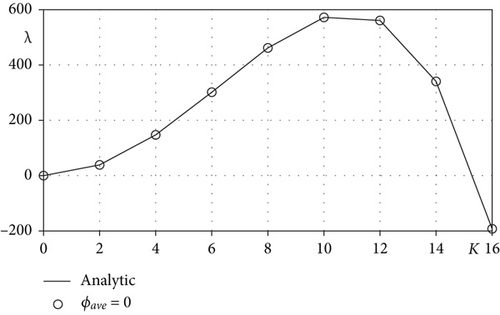
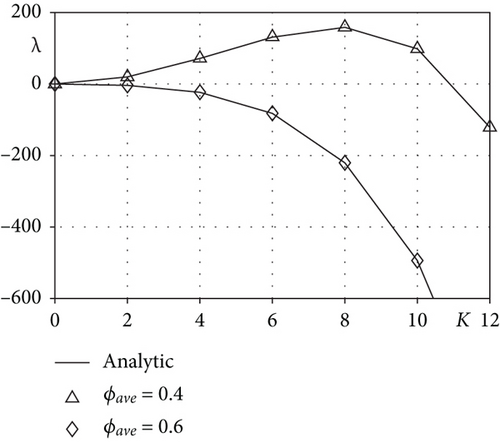
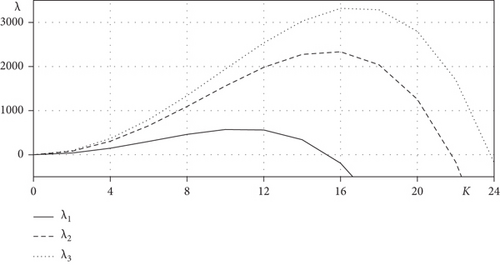


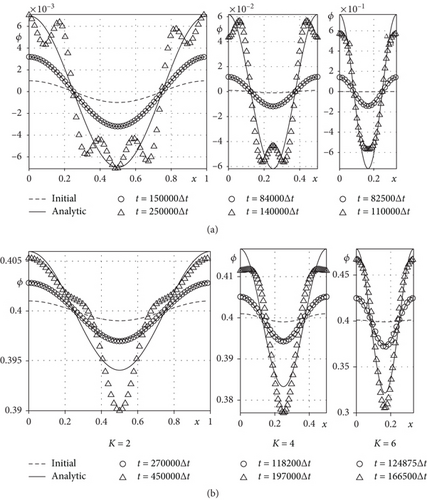
We compare short- and long-time numerical solution ϕ(x, t) when ϕave = 0 and ϕave = 0.4. In this test, we use mode K = 2 and α(0) = 0.1. As shown in Figure 5(a), we can see the nonlinearity in the long-time solution after a certain period of time, regardless of ϕave. Figures 5(b)–5(d) show results of double well potential F(ϕ), ε/2|∇ϕ|2, and F(ϕ) + ε/2|∇ϕ|2, respectively. Here, the solid and dashed lines mean the short- and long-time results of each function, respectively. Also, the area of the gray-colored region in Figures 5(b)–5(d) represent the energy , , and the Ginzburg–Landau free energy , respectively.

As shown in Figure 1, as ϕ moves away from ϕ = 0, F(ϕ) becomes smaller than F(0) when −1 ≤ ϕ ≤ 1. For this result, in Figure 5(b), dashed line is located below solid line overall of x. It means that F(ϕ) becomes smaller over time in the spinodal region. Also, according to fluctuation of ϕ, we can see the property of ε2/2|∇ϕ|2 in Figure 5(c). However, it can also be confirmed that the value has a slight effect on F(ϕ) + ε/2|∇ϕ|2 as shown in Figure 5(d). In conclusion, we know that the CH solution grows with time in the spinodal region, and it has nonlinearity in the existing solution in order to reduce the total free energy.
Figures 6(a)–6(c) show temporal evolution of , , and with different ε. All results of and decrease with respect to time t. However, it can be seen that the larger the epsilon, that is, the thicker the interface of numerical solution, the slower the result is expressed.
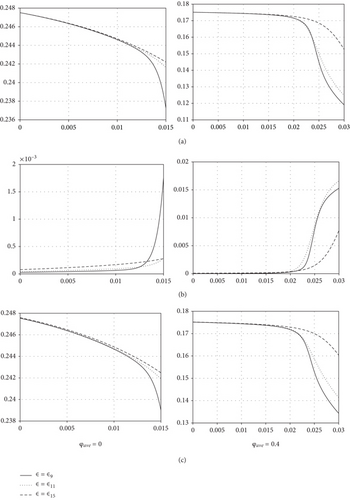
Figure 7 shows proposed criterion and temporal evolution of error e(t = nΔt) for the time t with dynamic of linear and numerical solutions.
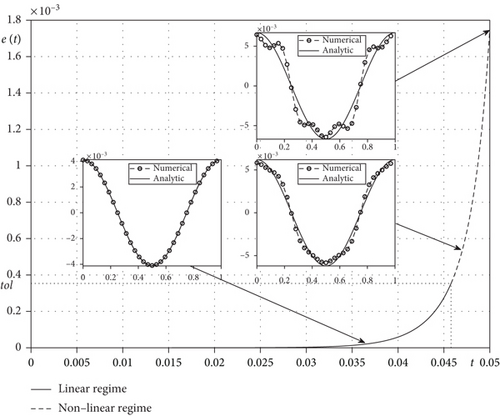
4. Conclusions
We studied a linear stability analysis for the CH equation in spinodal region as different average levels. To solve the CH equation, we used linearly stabilized splitting scheme and Fourier-spectral method. Through the numerical simulations, we observed various dynamics of the CH equation and confirmed the numerical solution compared linear solution over time. We defined growth rate and also compared numerical growth rate and analytic growth rate. Using difference between numerical and linear solution, we defined error. By means of defined error, we distinguish linear regime where numerical solution and linear solution match because of the small error and nonlinear regime where do not.
Conflicts of Interest
The authors declare that they have no conflicts of interest.
Acknowledgments
The first author (S. Ham) was supported by the Brain Korea 21 FOUR through the National Research Foundation of Korea funded by the Ministry of Education of Korea. This study was supported by 2020 Research Grant from Kangwon National University. The author (D. Jeong) was supported by the National Research Foundation of Korea (NRF) grant funded by the Korea government (MSIP) (NRF-2020R1F1A1A01075937). The corresponding author (J.S. Kim) was supported by Basic Science Research Program through the National Research Foundation of Korea (NRF).
Appendix
A. Appendix: Linearlization
Open Research
Data Availability
No data were used to support this study.




